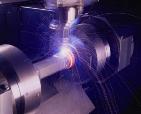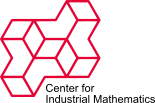Self optimizing simulation of laser welding
| Working Group: | WG Numerics of PDEs |
| Leadership: | Prof. Dr. Alfred Schmidt ((0421) 218-63851, E-Mail: alfred.schmidt@uni-bremen.de ) |
| Processor: | Dr.-Ing. Jonathan Montalvo Urquizo |
| Funding: | Zentrale Forschungsförderung Uni Bremen |
| Project partner: | Prof. Dr. Frank Vollertsen, BIAS |
| Time period: | 01.10.2004 - 30.06.2008 |

Situation
Within many ranges of industrial application, the welding of aluminium alloys using filler metal offers economical and process plant advantages compared to other technologies. There is a deficit in the evaluation of the influence of mixture behavior of base and filler material. The inhomogeneous mixture within the weld sea, proven in individual cases, explains among other things the observed appearance of hot crack in combination with filler metal welded components. At present, there is no scientific description of this basic problem sufficient to find technical and economical relevant solutions to avoid inhomogeneous element distributions and to achieve good mechanical properties of weld. For that reason mathematical based models have to be developed on basis of fluid dynamics simulations to obtain a prognosis of the element distribution within the weld sea and therefore a forecast of the hot crack affection. A further ambition is to develop, based on the fundamental evaluations, new strategies to reach a self-optimization of the welding procedure by numerical variations of the welding parameters. Special interest focuses on the modification of the partly commercially available simulation tools or to develop new optimising tools. Within the frame of simulation, self-optimizing algorithms should be implemented and a reduction of the effective simulation effort in combination with concurrently generation of reliable results will be reached.Engineering Aspects
The main goal of this project is to optimize the addition of filler material as well as to define convenient process parameters in respect to achieve hot cracks free weld clans (e.g., homogenization of the melt by alloying of the joint with silicon). Especially the influence of the temperature-time-regimes during the welding process has to be analyzed and has to be correlated with the dynamical processes of the mixture activity of melt-fluid metal. For that purpose, melt bath drifts must be simulated (inparticular: influence of the melt bath geometry and temperature) and melt pool dynamics and mixture activity in the joint have to be modelled and experimentally analyzed.Mathematical Aspects
Complete mathematical modells for laser welding processes should be developed, that in particular take into consideration the multi-scale structure of the problem (phases conversion on the micro level, energy transfer by the laser beam on the mesoscopic level, heat conduction on the macro level). The difficulty lies especially in the correct modelling of the transitions between these three physical phenomena. For numerical simulation of such multi-scale modells, efficient adaptive procedures have to be developed, for example wavelet or finite element methods.
Publications
- J. Montalvo Urquizo, Z. Akbay, A. Schmidt.
Adaptive finite element models applied to the laser welding problem.
Computational Materials Science, 46(1):245-254, Elsevier, 2009. - J. Montalvo Urquizo.
Simulation and Optimization of Laser Welding on Aluminium Alloys.
Dissertationsschrift, Universität Bremen, Dr. Hut Verlag, 2008. - Z. Akbay, J. Montalvo Urquizo, T. Pretorius, F. Vollertsen.
Fast FEM-Model and Keyhole-Heat Source Model for Self-Optimized Simulation of Laser Welding Processes.
International Workshop on Thermal Forming and Welding, 22.04.-23.04.2008, Bremen, Germany.
Thermal Forming and Welding Distortion, Proceedings of the IWOTE'08, F. Vollertsen, J. Sakkiettibutra (Eds.), pp. 277-288, 2008.

